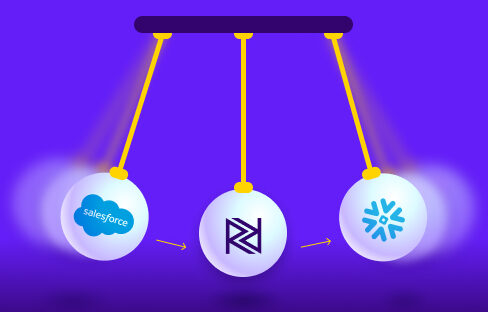Things are changing in data analytics. There is a solid shift towards operational analytics, where data is used to drive rapid decision-making. Data is actively channeled directly to the teams who use it, along with instructions on what to do with it.
When businesses are not leveraging data in the right way, data projects often fail and lead to financial strain. Investment in operational analytics can alleviate this strain from data teams, who usually carry a hefty price tag with them. In the realm of operational analytics, data teams become active players in delivering data projects with measurable return on investment (ROI) for business leaders, at a time when they need it most.
Why data projects fail
The first of these problems is about how businesses use people. All too often, data teams are seen as a cost, because organizations tend to answer problems by hiring more people. Instead of hiring people to do clever new things and create new value, they end up hiring people to just manage the same old inefficiencies, and to keep the wheels turning in the same old databases. Those people become ‘human middleware’ – a cost – rather than driving towards the goal of delivering business value.
There’s a second problem in terms of technology. In the modern data stack, it seems like new categories of needs in data pop up very regularly, and each one requires a new best-of-breed tool to deal with it. It’s easy to start believing that our businesses will perform better if we just adopt more technology. The problem is not derived directly from the technology itself, but is from our expectation that technology will solve problems and create efficiencies. On its own, technology won’t do that.
Thirdly, most existing data consumption still happens in a reactive manner – in business insights reports, or within a tool, and is approached in a centralized way by one data team, rather than by the teams who can act on it. Using data in this way doesn’t inspire action to be taken.
How operational analytics can improve ROI
To define operational analytics, it’s important to look at the consumption of data that happens in an operational system, for example Customer Relationship Management (CRM) software, or an engagement platform. Additionally, the data inspires or requires a clearly defined action by the user. Something happens in the data, you get a push alert, and then you do something.
All too often data consumption still happens in a reactive manner. While data is used for a report, it doesn’t inspire action. To deliver ROI, end users need to be equipped not just with the data, but the action they need to take with it.
Let’s take data pipelines, for example. Resolving issues that crop up when we’re building pipelines demonstrates how operational analytics can deliver measurable ROI. How? Let’s dig in. So imagine you’re a sales intelligence software company, your business model is product-led, so your primary goal is to get as many users as possible to sign up for a free trial so they can test drive the product and ultimately convert into paying customers. To get there and turn your leads into customers, you need to access the right data and get proactive about it.
To improve conversion rates from free trials to paying customers, you need to leverage data from trial accounts. The first step is to understand what the user is trying to do. Are they using your sales intelligence software to build prospect lists? To integrate with their CRM platform like Salesforce? How are they using your product exactly? Once you understand what they’re trying to do, a lot of friction is removed. You can target them with personalized technical assistance via the platform or chat and so on. To successfully offer this personalized help to end users, data should directly be in the hands of field teams.
Let’s take Rivery’s internal Slack environment as an example. We have a Slack channel, where we send a proactive message about what happens in each trial account so staff can reach out and respond with personalized engagement within one business day, often within minutes. This is then followed by a higher free trial conversion rate and generated revenue, where the data team is able to tie what they’re doing directly to the number-one metric of ROI: revenue. What we’ve seen is a 40% increase in terms of conversion with this proactive field team workflow, as well as helping the teamwork of our go-to-market effort.
How to embrace operational analytics
Business leaders need to plan carefully to deliver ROI using operational analytics, and equipping end users with the data they need, as well as clear instructions on what to do with it. As a first step to achieve business goals, organizations need to understand the ways to measure the results of data projects. Next, organizations need to work closely with the domain team such as sales or marketing, which are served with their data. It’s important to have an agreement or partnership in place so each team understands what the process will be, and which action they have to take.
This requires a ‘data as a product’ mindset, in which the analytical data set produced should be treated as a product. Applying product thinking to data can help improve discoverability, accessibility and usefulness. Another important part is decentralizing the ownership of data, and freeing it from being the ‘property’ of one central data team. One way to do this is through data mesh, a decentralized ‘self-serve’ approach to delivering data through an organization. That’s not possible for every company, though, as it requires a fairly large amount of resources and buy-in.
Whether fully adopting a data mesh methodology with data products across the org or not, most organizations should strive to make it so that the operational analytics use cases are actually owned by the domain teams with the domain expertise, such as sales teams, marketing teams and product designers. Those teams have the required background to act rapidly on insights delivered from data. Having that domain expertise is also crucial to obtaining and measuring results right from the outset, as well as modeling use cases. That doesn’t mean the technical setup isn’t supported by the data team but ultimately, the usage and adjustments of the workflow over time are the responsibility of the domain teams.
The final part concerns keeping within a source system where possible. Don’t just use reverse ETL (the technical term for pushing the data from a data warehouse to the operational systems) for the sake of it. Leaders must ask themselves: are we just replicating data from one system to another? Do we really need a data warehouse in the mix? There are plenty of application tools out there such as an event-based framework within CRM software, which might be all that’s required.
These small changes all move analytics towards a streamlined, decentralized people-centered approach, helping deliver data to the place where it can make a difference.
A new way to deal with data
For business leaders frustrated with the speed with which data projects deliver value, operational analytics offers a new way forward. It delivers measurable returns, rather than simply consuming money and time. Taking a ‘data as product’ mindset is central to successful operational analytics. So is communication with domain experts and decentralization of how data is used within an organization.
These aren’t always easy changes to implement and may take time. Moving forward, the benefits of operational analytics will become clear across organizations – from the teams who are empowered with data, to company leaders who will see measurable returns on their investments.
Minimize the firefighting. Maximize ROI on pipelines.





